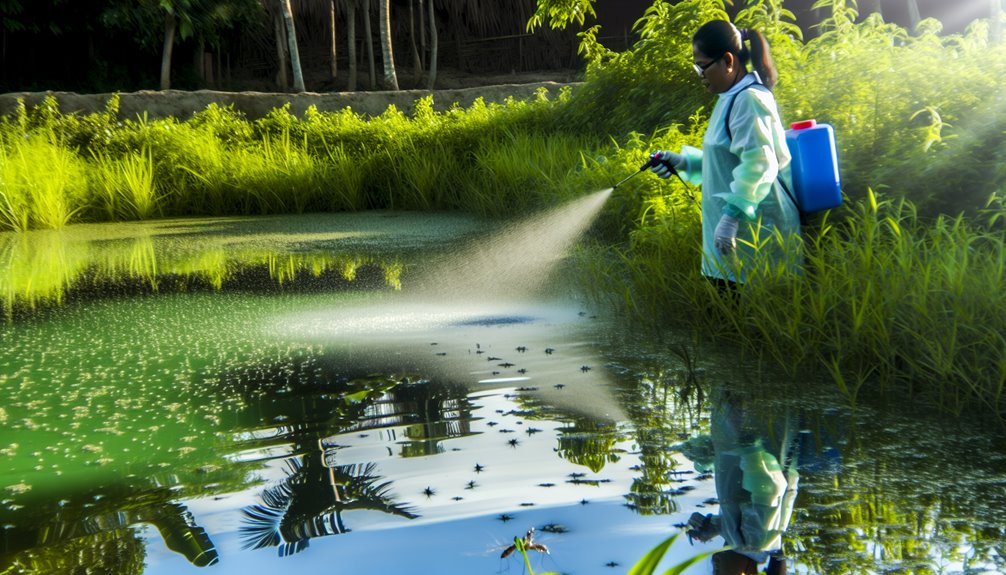You might not know that a single neglected puddle can produce hundreds of adult mosquitoes in a week. When you target larvae with biological agents like Bti or insect growth regulators (e.g., methoprene), you interrupt molting or gut function with high specificity, sparing non-target fauna. Applied to known habitats at the right interval, larvicides cut emergence rates by 80–95% in trials, reducing biting risk and virus transmission potential—if you time and place them correctly…
Understanding the Mosquito Life Cycle and Its Weak Points

Although adult mosquitoes draw most attention, the life cycle’s leverage points lie earlier: egg, larva, pupa, then adult. You disrupt mosquito reproduction by targeting aquatic stages concentrated in measurable habitats. Females oviposit within hours after blood meals; eggs hatch in 24–72 hours depending on temperature. Larvae filter-feed, molt four times, and develop in 4–10 days; pupae emerge in 1–4 days. Habitat preferences are species-specific: Culex favor organically enriched catch basins; Aedes select small, containerized water; Anopheles prefer clean, sunlit pools. You’ll gain control by mapping water volumes, turnover rates, shading, and organic load, then prioritizing sites yielding the highest adult emergence.
Types of Larvicides and How They Work
By focusing on aquatic stages, you can pair habitat mapping with targeted larvicides that interrupt development before emergence. You’ll choose between biological larvicides and chemical larvicides based on water quality, target species, and operational goals. Bacillus thuringiensis israelensis (Bti) and Bacillus sphaericus (Ls) deliver crystalline toxins that bind larval midgut receptors, causing gut paralysis and death; meta-analyses show >90% mortality within 24–48 hours with minimal non-target impacts. Insect growth regulators like methoprene mimic juvenile hormone, preventing pupation. Monomolecular films reduce surface tension, drowning larvae and pupae. Organophosphates (e.g., temephos) inhibit acetylcholinesterase, but resistance surveillance and rotation maintain efficacy.
Best Times and Places to Apply Larvicides

When surveillance shows early instar (L1–L3) densities rising in productive habitats, apply larvicides before peak emergence to maximize kill and minimize retreatment. You’ll enhance application timing by pairing weekly dipping with temperature-driven degree-day models; target treatments when cohorts reach L2–L3 and rainfall replenishes breeding sites. Prioritize ideal locations with repeat productivity and high vector indices.
- Focus on catch basins, stormwater ponds, tire piles, and rice fields with ≥20% positive dips.
- Treat after measurable precipitation (>10–15 mm) or irrigation cycles that refresh standing water.
- Revisit sites on product-specific intervals (e.g., 7–14 days Bti; 21–30 days IGRs) to maintain suppression.
Safety, Environmental Considerations, and Regulations
Effective timing and site selection only deliver lasting control if you apply larvicides within safety, environmental, and regulatory guardrails. You should verify product labels, active ingredients, and target species, then calibrate equipment to deliver labeled rates (e.g., Bti 0.2–1.2 kg/ha; methoprene 0.011–0.048 mg/L). Document mixing, lot numbers, and weather to guarantee regulatory compliance and traceability. Protect non-targets by mapping wetlands, buffer zones, and endangered species habitats; monitor dissolved oxygen, pH, and conductivity pre/post-application. Use drift-reduction nozzles, PPE, and spill kits. Report treatments to authorities and stakeholders, archive QA/QC data, and audit environmental impact using sentinel bioassays.
Proactive Strategies vs. Adulticide Spraying Outcomes

Although adulticide spraying can quickly knock down flying mosquitoes, proactive larval control and source reduction deliver larger, more durable population declines at lower cost per hectare and with fewer non-target impacts. You’ll see higher return on effort when you disrupt aquatic stages using Bacillus thuringiensis israelensis, methoprene, and habitat modification within integrated pest management.
- Target hotspots with GIS mapping; treat before emergence to reduce biting pressure 70–95%.
- Pair larviciding with community education to eliminate containers, gutters, and tire piles.
- Monitor pupal indices weekly; adjust dosage by habitat and rainfall.
Adulticides remain surge tools; proactive programs stabilize transmission risk and protect service budgets.
Conclusion
I truly believe that taking a proactive approach to mosquito control is the best way to protect our families and communities from those pesky bites. Here at Mosquito Eliminators of South MS, we’re passionate about using effective larvicide applications to tackle mosquito populations before they can become a nuisance. If you want to learn more about how we can help you enjoy your outdoor spaces without the worry of mosquitoes, I invite you to visit us at mosquitoeliminatorsms.com or give us a call at (601) 336-2277. Together, we can create a comfortable and safe environment for everyone. Looking forward to hearing from you!

